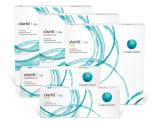
Childhood myopia (or nearsightedness) is commonly caused by abnormal eye growth and tends to lead to higher prescriptions over time.1 MiSight® 1 day soft contact lenses are the first and only FDA-approved* product proven to slow the progression of myopia in children aged 8 to 12 at the initiation of treatment.2† These contact lenses offer "always-on" myopia control because children wear them all day and they don't get in the way of active lifestyles.3≠
When children become more skilled at soft contact lens insertion and removal, they would more easily wear MiSight® 1 day for the recommended 10+ hours per day, 6 days a week.2µ As a result of adhering to the treatment schedule, children may have a better chance of slowing their myopia progression4,5 and lowering the risk of future vision problems.6
This is great news and good motivation for parents to encourage their children to learn how to insert and remove their contact lenses. Your eye care professional is likely to demonstrate and provide instructions on contact lens insertion and removal when they prescribe MiSight® 1 day.
Contact lens insertion and removal for kids
After your child has been diagnosed with myopia and received their contact lens prescription, the next step is making sure that they can insert and remove them with ease. While it may seem daunting, contact lens insertion and removal is actually very achievable.
Step-by-step instructions for easy contact lens insertion and removal
With MiSight® 1 day, children as young as eight years old are able to insert and remove their daily disposable soft contact lenses on their own.2µ And just like any other routine, getting used to putting in and taking out contact lenses is as simple as going step-by-step. With time and practice, it will start to feel like second nature.
Just watch how eight-year-old twins, Olivia and Madeline achieve contact lens insertion and removal all on their own. With soft contact lenses, they can continue to be just like their friends, pursuing gymnastics and having fun on the playground without any additional obstacles.
The importance of helping kids with myopia
When your child has myopia, you may worry about how it might interfere with their quality of life, such as making it harder for them to participate in school, sports, or other daily activities.7,8 On the scarier side of the spectrum, you may have also heard about how, as a child's myopia worsens, it increases the risk of sight-threatening eye health conditions later in life, such as retinal detachment, myopic maculopathy, glaucoma, and cataracts.6,9-11
Additionally, you may have noticed how children's lifestyle habits are changing. Reduced outdoor time has been shown to impact the development of myopia while increased time spent on close-up activities, such as reading and digital devices, may potentially play a role too.12-14 Myopia generally continues to worsen throughout the teenage years and may start to stabilize by their early 20s.15
The good news is that you can help to protect your kid’s vision from worsening as they grow with MiSight® 1 day soft contact lenses.2† These contact lenses are child-friendly and easy-to-use2 and with a bit of practice, they will be able to insert± and remove∞ their MiSight® 1 day with ease.16
Indications and Important Safety Information.
Rx only.
Results may vary.
ATTENTION: Reference the Patient Information Booklet for a complete listing of Indications and
Important Safety Information. *USA Indication: MiSight® 1 day (omafilcon A) soft (hydrophilic)
contact lenses for daily wear are indicated for the correction of myopic ametropia and for slowing the progression of myopia in children with non-diseased eyes, who at the initiation of treatment are 8-12 years of age and have a refraction of -0.75 to -4.00 diopters (spherical equivalent) with ≤ 0.75 diopters of astigmatism. The lens is to be discarded after each removal. Canadian Indication: MiSight® (omafilcon A) Soft Contact Lenses for Myopia Control are indicated for the correction of ametropia (myopia and hyperopia) in aphakic and non-aphakic persons with non-diseased eyes in powers from -20.00D to +2.00 diopters. The lenses may be worn by persons who exhibit astigmatism of -2.00 diopters or less that does not interfere with visual acuity. MiSight (omafilcon A) Soft Contact Lenses for Myopia Control may reduce the rate of myopia progression in children (6-18) and correct ametropia. Reduction of myopia progression was observed in children with wearing time of 12 hours (8-16 hours) per day, 6.4 days (5-7) per week in a clinical study. Permanent myopia control after lens treatment is discontinued is not supported by clinical studies. MiSight (omafilcon A) Soft Contact Lenses for Myopia Control are indicated for single use daily disposable wear. When prescribed for daily disposable wear, the lens is to be discarded after each removal. Warnings: Problems with contact lenses could result in serious injury to the eye. Do not expose contact lenses to water while wearing them. No overnight wear. Patients should exercise extra care if performing potentially hazardous activities. Adverse events: Including but not limited to infection/inflammation/ulceration/abrasion of the cornea, other parts of the eye or eyelids. Some of these adverse reactions can cause permanent or temporary loss of vision. If you notice any of the stated adverse reactions in your child, immediately have your child remove the lenses and contact your eye care professional.
† Compared to a single vision lens over a 3 year period.
≠ In clinical study, mean weekday wear time increased from 12.8 hours/day at 6-months to 13.9 hours/day at 6-years with a mean of >6.5 days/week.
µ As reported by parents.
± After 1 month of wear.
∞ From 1 week of wear through 3 years of wear.
- Hou W, et al. Axial Elongation in Myopic Children and its Association With Myopia Progression in the Correction of Myopia Evaluation Trial. Eye Contact Lens. 2018 Jul;44(4):248-259.
- Chamberlain P, et al. A 3-year randomized clinical trial of MiSight® lenses for myopia control. Optom Vis Sci. 2019;96(8):556-567.
- Woods J et al. Ocular health of children wearing daily disposable contact lenses over a 6-year period. CLAE 2021 Aug;44(4):101391.
- Lam CSY, et al. Defocus Incorporated Soft Contact (DISC) lens slows myopia progression in Hong Kong Chinese schoolchildren: a 2-year randomised clinical trial. BJO 2014;98:40-45.
- Bao J, et al. Myopia control with spectacle lenses with aspherical lenslets: a 2-year randomized clinical trial. IOVS 2021;62:2888
- Flitcroft DI. The complex interactions of retinal, optical and environmental factors in myopia aetiology. Prog Retin Eye Res. 2013;31(6):622-660.
- E. L. Lamoureux, J. Wang, T. Aung, S. M. Saw, T. Y. Wong; Myopia and Quality of Life: The Singapore Malay Eye Study (SiMES). Invest. Ophthalmol. Vis. Sci. 2008;49(13):4469.
- Chua S.Y.L., Foster P.J. (2020) The Economic and Societal Impact of Myopia and High Myopia. In: Ang M., Wong T. (eds) Updates on Myopia. Springer, Singapore.
- Xu L, Wang Y, Wang S, Jonas JB. High myopia and glaucoma susceptibility, the Beijing Eye Study. Ophthalmology. 2007;114(2):216-20.
- Younan C, et al. Myopia and incident cataract and cataract surgery: the blue mountains eye study. Invest Ophthalmol Vis Sci. 2002;43(12):3625-3632.
- Chen SJ, et al. Prevalence and associated risk factors of myopic maculopathy in elderly Chinese: the Shihpai eye study. Invest Ophthalmol Vis Sci. 2012;53(8):4868-73.
- Xiong S, Sankaridurg P, Naduvilath T, Zang J, Zou H, Zhu J, Lv M, He X, Xu X. Time spent in outdoor activities in relation to myopia prevention and control: a meta-analysis and systematic review. Acta Ophthalmol. 2017 Sep;95(6):551-566. doi:10.1111/aos.13403. Epub 2017 Mar 2. PMID: 28251836; PMCID: PMC5599950.
- Huang HM, Chang DS, Wu PC. The Association between Near Work Activities and Myopia in Children-A Systematic Review and Meta-Analysis. PLoS One. 2015 Oct 20;10(10):e0140419. doi: 10.1371/journal.pone.0140419. PMID: 26485393; PMCID: PMC4618477.
- Lanca C, Saw SM. The association between digital screen time and myopia: A systematic review. Ophthalmic Physiol Opt. 2020 Mar;40(2):216-229. doi: 10.1111/opo.12657. Epub 2020 Jan 13. PMID: 31943280.
- https://www.healthychildren.org/English/health-issues/conditions/eyes/Pages/Myopia-Nearsightedness.aspx. Accessed July 2024.
- Sulley A et al, Wearer experience and subjective responses with dual focus compared to spherical, single vision soft contact lenses in children during a 3-year clinical trial. AAO 2019 Poster Presentation






